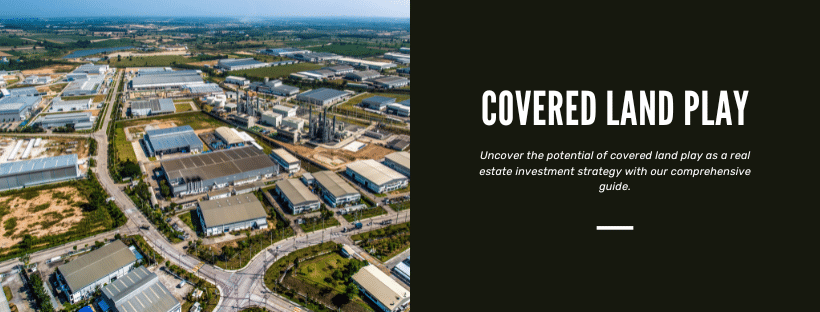What is Covered Land Play?

A covered land play is a real estate strategy. It is a valuable investment concept that focuses on the increased value a property represents that’s covered. Though a bit more complex, it helps to see how this may work.
What Is a Covered Land Play?
A covered land play is an investment strategy focused on the value of a piece of property. To understand it, first, consider the “highest and best use” of a property. This term is used to describe the property’s current use and that it is earning at its highest possible use at this point. In other words, how the property functions now is the best, most valuable use of that property.
A covered land play describes a situation in which a real estate investor locates a property that is not being used to its highest and best use. Rather, it has potential if redeveloped, to provide better value.
However, the site, in its current condition, is producing enough income to cover the costs that are currently associated with the real estate. That is, until the redevelopment of the property can occur, the property’s current income will cover its current costs. This means it’s a covered land play.
Answer a few questions and get custom mortgage quotes. We'll match you with offers from our network of 650+ lenders.
Common Examples of Covered Land Play
There are various ways this can occur. Consider a few land cover examples.
Redevelopment
Redevelopment of a property is a common covered land play investment. In short, it means tearing down and rebuilding into something new. In the simplest of terms, this could mean removing a single-story property and building a large complex. That would open the door to higher revenue.
Redevelopment of a property typically focuses on creating a new use for the property, redeveloping the actual function of the property with the goal of increasing its value.
Mixed-Use Development
Other common land cover types relate to creating a mixed-use development. That means the property is being used for multiple purposes, such as residential and retail. A common strategy in some larger and urban cities has been to redevelop areas like manufacturing centers into mixed-use properties with retail at the base level and condos and lofts above. However, mixed-use can focus on other combinations of use as well, such as the use of a sector for light warehousing and retail development.
Office Park Conversion
An office park conversion is another example of a comprehensive new way to use a property. In some locations, this could relate to the comprehensive redevelopment projects of an industrial building, an old shopping mall, or a school into an office park. It could include the combination of retail and office space used together as well.
Other Projects That Are Considered Covered Land Plays
Any update or improvement, not just in terms of adding a new structure to the property, could be a covered land play. Here are a few examples.
- Urban density improvement: Utilizing as much of the property as possible to create a higher density of tenants could be an option in some areas, dependent on building codes, total height, and type of use.
- Parking lots: A parking lot is perhaps one of the simplest of covered land plays since they do not require much work to establish or maintain but can help to provide enough income to offset some projects.
- Operating as a tenant: It’s possible for a property owner to move into their vacant building and become an onsite owner. This could reduce rental costs elsewhere and enable the company to tap into available loans to cover the cost of updating, such as through SBA 7a and SBA 504 loans.
- Partner with property owners: In this scenario, the real estate investor partners with a current owner that has significant excess property that could then be redeveloped into a more lucrative use.
Benefits and Risks of Covered Land Play
Like all investment strategies, there are some risks and benefits associated with covered land plays. Ultimately, a covered land play strategy is dependent on how well the developer can transform the property into a usable investment that earns a higher income. Poor workmanship or a failed venture creates significant risk.
The benefits of a covered land play include:
- There’s a high potential for an upsell. If the property is capable of being improved upon by the investor, he or she can then turn around and sell that property for a much higher value, dependent on factors such as the costs and current market conditions.
- It’s easier to finance a covered land deal. If the property has a tenant already in it that is paying rent, or another steady stream of income, that can easily convince today’s lenders to lend. The deal is likely bankable.
There are risks associated with covered land play real estate investments, including:
- Overpaying is the biggest risk. Those who overpay on cap rate or do not create an accurate estimation of the strength of the operating business could weaken any transaction’s future goals.
- If a tenant leaves, who is providing the covered land investment, that could mean the company is unable to continue to maintain the property unless they have the capital to do so.
The key to remember when it comes to a covered land play investment is that the goal is to focus on the value of the land and not on the people that are currently renting it. That is, it is also essential to understand the value of the property based on the local economic conditions and needs within the community.
Who Should Consider Covered Land Play?
The biggest risk to any of these land cover examples is a lack of due diligence. Research and development of any land redevelopment can take some time and requires a careful eye for what the community will see as valuable, not just building a big structure on a small lot. For this reason, those who are considering a covered land play should invest wisely in due diligence and have experience in the community and investment strategy being pursued.
Beyond this, investors who are looking for opportunities to maximize their investment over time should consider the value of a covered land play. For many investors, this may be an opportunity to purchase, redevelop, and sell, but for others, it allows for long-term growth dependent on the change in economic conditions or the unique needs of the community.
It also takes some time. Investors must have enough time to manage the entire redevelopment, which could be hampered by building codes and permits. It may also require careful legal maneuvering to minimize the risk associated with how the property is functioning.
Wrapping Things Up
A covered land play is an opportunity for investors to earn more than what the current property income is if they can affordably invest and build on that value. As a covered land play, specifically, the property has the means to cover its current costs right now, giving investors less risk to take on the project.
Yet, there is a need to research and complete due diligence to determine if a new use for the property would be beneficial or even allowable within the local community. Having the right insight and support in a project like this can prove essential.

